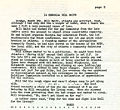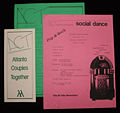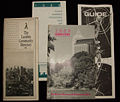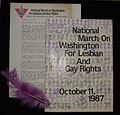Difference between revisions of "AIDS and Politics - 1980 to 1989"
| Line 5: | Line 5: | ||
<gallery> | <gallery> | ||
| − | Image: | + | Image:Atalanta note about Bill Smith.jpg|Courtesy of the Kenan Research Center at the Atlanta History Center. |
| + | |||
| + | Image:Atalanta article about Bill Smith.jpg|Courtesy of the Kenan Research Center at the Atlanta History Center. | ||
Image:Atlanta Gay Center_Ponce_AHC.jpg|Photograph, Atlanta Gay Center, circa 1980. Photographer unknown. Courtesy of the Kenan Research Center at the Atlanta History Center. | Image:Atlanta Gay Center_Ponce_AHC.jpg|Photograph, Atlanta Gay Center, circa 1980. Photographer unknown. Courtesy of the Kenan Research Center at the Atlanta History Center. | ||
| + | |||
| + | Image:First Tuesday candidates rating_1980_AHC.jpg|Flyer, First Tuesday, 1980. Courtesy of the Kenan Research Center at the Atlanta History Center. | ||
Image:AID Atlanta newsletter 1983_AHC.jpg|Newsletter, AID Atlanta, 1983. Courtesy of the Kenan Research Center at the Atlanta History Center. | Image:AID Atlanta newsletter 1983_AHC.jpg|Newsletter, AID Atlanta, 1983. Courtesy of the Kenan Research Center at the Atlanta History Center. | ||
| Line 13: | Line 17: | ||
Image:Pulse_cover.jpg|First issue, ''PULSE'', 1984. Courtesy of the Kenan Research Center at the Atlanta History Center. | Image:Pulse_cover.jpg|First issue, ''PULSE'', 1984. Courtesy of the Kenan Research Center at the Atlanta History Center. | ||
| − | Image: | + | Image:The Journal_Aid Atlanta_1988_AARL.jpg|Courtesy of the Archives Division, Auburn Avenue Research Library on African American Culture and History. |
| − | Image: | + | Image:BWMT letter_1988_AARL.jpg|Courtesy of the Archives Division, Auburn Avenue Research Library on African American Culture and History. |
</gallery> | </gallery> | ||
| Line 33: | Line 37: | ||
Image:140.jpg|Advertisement featuring performer RuPaul, Weekends, 1984. Courtesy of the Kenan Research Center at the Atlanta History Center. | Image:140.jpg|Advertisement featuring performer RuPaul, Weekends, 1984. Courtesy of the Kenan Research Center at the Atlanta History Center. | ||
| + | |||
| + | Image:Insight newsletter_AHC_1985.jpg|Newsletter, the Montgomery Foundation Gender Dysphoric Association, 1985. Courtesy of the Kenan Research Center at the Atlanta History Center. | ||
| + | |||
| + | Image:Atlanta Gay Guides_1986-1989_AARL.jpg|Guides, 1986-1989. Courtesy of the Archives Division, Auburn Avenue Research Library on African American Culture and History. | ||
Revision as of 12:51, 21 May 2010
AIDS and Politics - 1980 to 1989
The popularity of bars and parties did not wane in the 1980s, but the gay and social political landscape of Atlanta, as in other major cities, was transformed by the AIDS crisis. Though AIDS first came to national attention in 1981, in Atlanta, thanks in part to the presence of the Centers for Disease Control, gay activists began organizing around the issue as early as 1983. AID Atlanta, an all-volunteer educational and service organization, was among the first groups that formed. By the end of the decade, there existed a network of HIV/AIDS support and activism, including a local chapter of the AIDS Coalition to Unleash Power (ACT-UP) and programs and organizations to address women and communities of color.
Much, though not all, activism during this decade centered on AIDS, and lesbians played an important role in the movement to educate people and to combat the increasingly vocal antigay forces from the Christian right and the Republican Party. All the while, evangelical ministers, among them Charles Stanley of the First Baptist Church of Atlanta, preached that HIV/AIDS was God's punishment for homosexuality. When Georgia native J. B. Stoner, a lifelong segregationist and white supremacist, led a mob confronting civil rights marchers in Forsyth County, Georgia, in 1987, he passed out leaflets that read "Praise God for AIDS" across the top.
During the same period, another event of national import occurred, when in 1982, Atlantan Michael Hardwick was arrested in his bedroom for engaging in oral sex with another man. Hardwick appealed, aided by the ACLU and Georgians Opposed to Archaic Laws, but in 1986 the case reached the U.S. Supreme Court, which upheld Georgia’s sodomy statute. In response to the Hardwick case, a strong belief that the U.S. government was failing to adequately address the AIDS crisis, and ongoing discrimination, LGBT Atlantans responded vocally and visibly in local marches and rallies, as well as the second national March on Washington for Lesbian and Gay Rights in 1987.
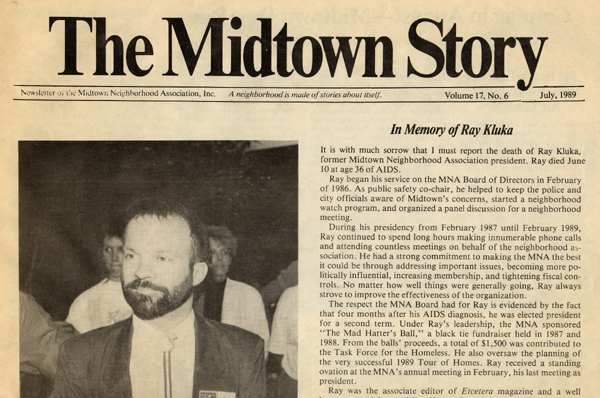
Collective Power and Culture Wars - 1990 to 1999
Atlanta Since Stonewall, 1969-2009: A Local History <comments />

